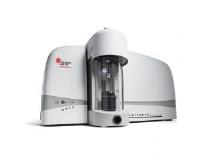 Add My Company
Add My Company
Sign In

Multiple technologies and methods exist for performing particle size analysis with the intention of testing the mechanical, chemical, or biophysical properties of a sample. These methodologies include dynamic light scattering (DLS), permeability measurements, and laser diffraction particle size analysis.
Laser diffraction particle size analysis is a common technique applied to measure particles ranging from nanometer (nm) to millimeter dimensions, informing the geometrical characterization of particles in a sample. This process can be used to measure solid and liquid particles, including solids dispersed or dissolved in a solution.
This article will explore laser diffraction particle size analysis in more detail:
Laser Diffraction Working Principle
Laser diffraction particle size analysis operates on two primary optical theories: Fraunhofer diffraction and Mie scattering. These calculations are used to determine the diffraction patterns of different particle sizes prior to performing actual measurements. These can be used to approximate the intensity of scattered light, the scattering angle, and thus the particle?s geometric parameters.
In basic terminology, Fraunhofer diffraction suggests that the angle and intensity of light scattered from a particle is proportional to its geometric parameters. Mie theory refers to a series of mathematical computations, but is generally applied to analyze submicron-sized particles that are smaller than the wavelengths of the incident light. Conventionally, laser diffraction particle size analysis relied on either generalized Fraunhofer diffraction or predefined Mie scattering information, but particle analyzers are increasingly enabled for full implementation of both theories to provide a more dynamic sampling range.
This theoretical foundation supports the intuitive hardware of a laser diffraction particle analyzer, which operates using an incident laser beam generated by a diode or tungsten lamps fitted with robust bandpass filters. The wavelengths of the incident light can vary from blue light at a wavelength of 475 nm, to near infrared at a wavelength of 900 nm. These are directed into a sample towards a highly-sensitive detector fitted with robust bandpass filters capable of discriminating between the incident light source and diffracted light.
Diffraction pattern imagery is then generated by the particle size analyzer, with additional functionalities available for high-end laser diffraction instruments. The LS 13 320 XR laser diffraction particle analyzer, for example, is equipped with enhanced polarization intensity differential scattering (PIDS) technology to improve scattered light detection for submicron particles, enabling an enhanced dynamic range of 10nm ? 3,000?m.
Laser diffraction particle size analyzers, such as the LS 13 320 XR, are equipped to perform particle analysis for a broad range of sectors and disciplines, including:
Academic research;
Material characterization;
Soil and sediment analysis;
Microfabrication research;
Water treatment analysis.
Laser Diffraction Particle Size Analysis from Meritics
Meritics is a leading supplier of particle analysis equipment for numerous fields of research, with a detailed understanding of new and emerging equipment for materials characterization on both micro- and macro-scales.
For more information on Outlining Laser Diffraction Particle Size Analysis talk to Meritics Ltd
Enquire Now
List your company on FindTheNeedle.

